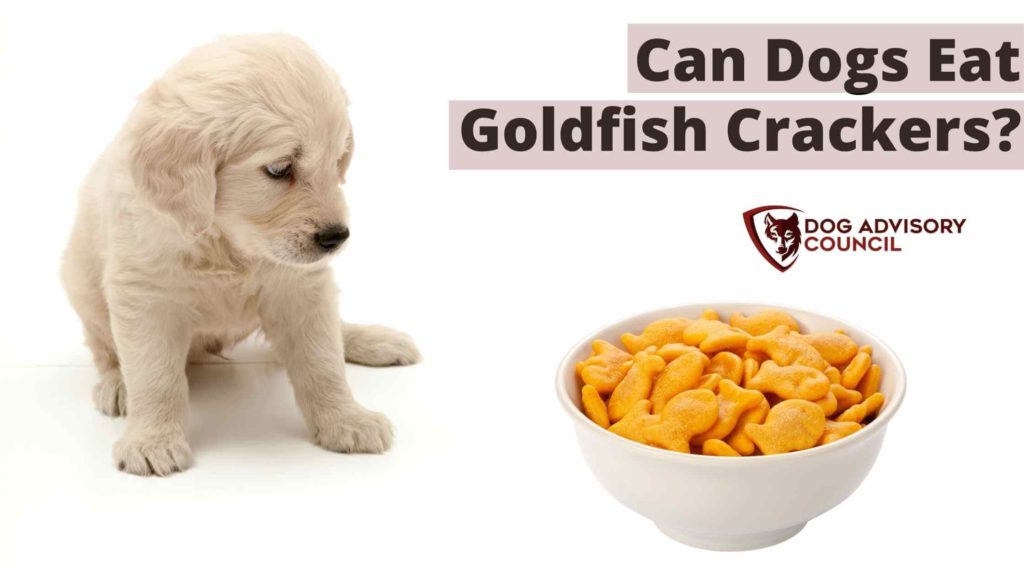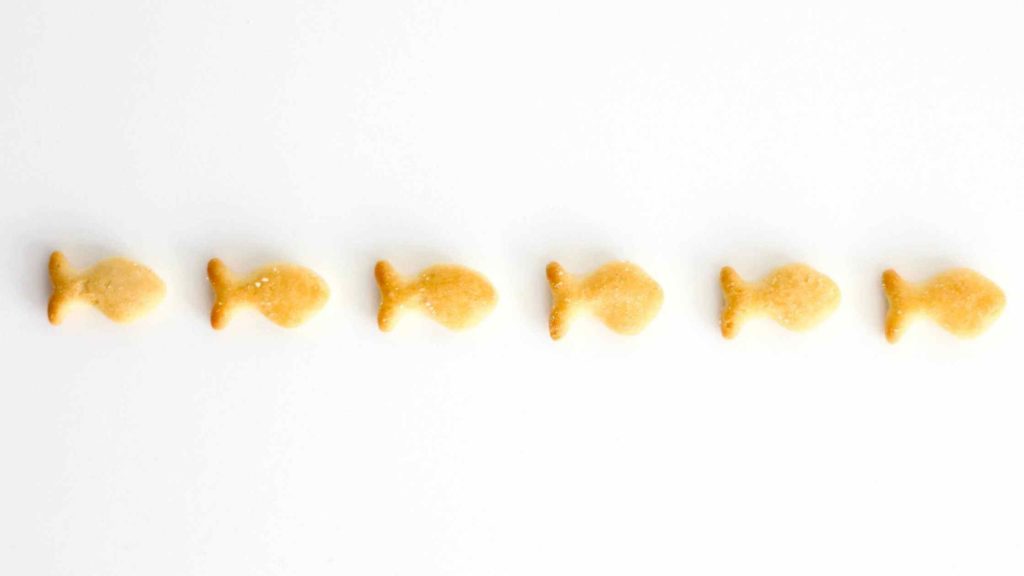
Goldfish crackers are delicious, but can dogs eat goldfish crackers? Here’s what you should know about them!
There are no harmful ingredients in certain types of goldfish crackers for your dog, so you can safely share a cracker or two with them on occasion if you buy the right type. However, goldfish crackers have no nutritional value for your dog and can have harmful ingredients depending on what type of goldfish crackers you get.
As such, there are many better snacks that you can offer that have no chance of potentially derailing your dog’s diet.
Are goldfish good for dogs?
While they are a staple in the lunch box of many school children (and adults!), they are not recommended for dogs. There are two types of goldfish crackers to learn about:
- Dog-safe goldfish crackers
- Non-dog-safe goldfish crackers
Dog-safe goldfish crackers
These would be your goldfish crackers (be them name brand or off-brand) that are made using the classic recipe. This would contain plenty of flavor for us humans, including salt and fat, but nothing additional like onion or garlic.
These original recipe goldfish crackers are okay to share in small servings to dogs because they aren’t dangerous, just not recommended.
Non-dog-safe goldfish crackers
These could be name-brand or off-brand as well. These would taste the same to us, as humans, but contain onion salt, garlic salt, and other potent flavoring and seasoning ingredients that are dangerous for dogs. If your dog were to eat those, they can have a toxic reaction to those dangerous ingredients and require emergency vet assistance.
So…how do you know the difference between dog-safe and non-dog-safe goldfish crackers from the taste? You don’t! If you’re firm on sharing your goldfish with your dog, check the box’s ingredients list every single time. Even if you buy the same type from the same brand every time you go shopping, check its ingredients before sharing.
Many companies will change their ingredients in something as “insignificant” as flavorings or seasonings, and you wouldn’t know it. This change can be the difference between a healthy and dangerous treat.
Toxic ingredients in goldfish crackers for dogs
There are quite a few dangerous ingredients in goldfish crackers, but here is a complete list of the ones in the traditional unaltered cheddar recipe:
- Onion salt
- Onion powder
- Garlic salt
- Garlic powder
- Salt
Onion and garlic can both poison your dog even in tiny amounts because the seasonings are always more potent than the actual onion or garlic clove itself. Depending on your dog’s size and sensitivity, a handful of goldfish is all it could take.
Salt is something that quickly can cause a reaction in your dog, and you wouldn’t even know it. Dogs naturally eat low-salt diets, and goldfish crackers are naturally high in sodium, even for humans. This salt content can cause salt toxicity in dogs.
What happens if a dog eats goldfish?
In many cases, you won’t notice anything other than mild indigestion or some diarrhea, depending on your dog’s natural sensitivity. This is assuming one goldfish cracker, or perhaps up to 3. This also assumes that you’ve got a medium-sized dog.
However, poisoning from the ingredients can occur quickly. Symptoms will show up in the first 24 hours and most often between the first 6-12 hours. These include:
- Anemia
- Difficulty breathing
- Pale coloring around the eyes and nose
- Lethargy
- Vomiting
- Diarrhea
- Dehydration
If you notice any of these symptoms, your dog is having a poison reaction, and you will need to get them to an emergency vet for them to step in. If untreated, this poison reaction can be fatal!
Can goldfish kill a dog?
As hinted at briefly, yes! A goldfish cracker can kill your dog. It seems so harmless to us, but the seasonings in a single cracker can be enough to cause poisoning in some dogs.
You can safely assume that a Great Dane would be okay with one goldfish cracker, but a chihuahua would be much more likely to have a toxic reaction. However, most dog experts won’t recommend taking any such risk with goldfish crackers containing those ingredients nonetheless.
How many goldfish can a dog have?
We get it. You really want to share your goldfish crackers with your dog. After all, they’re your favorite, and your dog is insisting that they’re perfect for sharing. If you want to give your dog a treat, then focus on these details:
- Your dog’s size
- Your dog’s health
- Your dog’s sensitivities to food
- The type of goldfish crackers
- The number of goldfish crackers
- Your vet’s recommendation
So many people will skip this last step, but it’s essential! You must talk to your vet first to have an expert take a look at all of these details you’ve put together. Many don’t want their vet’s judgment and disapproval, so many will bypass it.
But remember: your vet always has your dog’s best interest in mind. If they tell you that your details are not recommended and cause a health emergency, you should listen to them. Many will offer specialized advice on how many you can give and what type you can give if you are really firm on it. Your vet will work alongside you as an ally if you let them.

What to do if your dog ate goldfish?
Sometimes we come back to an empty bowl and a guilty-looking dog. It happens. If this is the scenario, here are the steps to follow:
- Check the ingredients on the box
- Estimate how many they’ve eaten
- Call your vet and let them know what’s happened
- Monitor for symptoms
- Act if needed
Check the ingredients on the box
The ingredients will help you know whether they are dog-safe or non-dog-safe goldfish crackers. Read through them carefully and slowly and look for those problem ingredients that we talked about. The salt content is on the nutritional label, so don’t forget that one!
Estimate how many they’ve eaten
This will help you get a rough idea of how much salt they’ve ingested and whether or not they’ve had enough of any of the potentially serious ingredients to cause a problem.
Whatever the amount is, make it a bit higher than your rough guess. When it comes to a potentially toxic reaction, it’s always best to round up so that you’re working with the correct assumption for amounts.
Call your vet and let them know what’s happened
With that information ready, call your vet and let them know about the crackers. Depending on their own criteria, they’ll recommend that you watch for symptoms, or they’ll recommend bringing him in.
If you are asked to watch for symptoms, you’ll also want to ask whether you can or should feed them a bland diet. This can also help settle your dog’s upset stomach in the scenario where they’ve got too much fat and salt digesting at one time.
Monitor for symptoms
Watch for any symptoms to appear from the poisoning, and be ready to jump into the car and take your dog to the vet. The more that they have, the more serious they are. Don’t wait for 2 or 3 to appear, though. Take them in if you notice even 1 of those.
Sometimes your vet can suggest other symptoms that might appear, too. Don’t wait for your vet office to open in the morning because it might be too late. Poison is always a medical emergency.
Act if needed
This is important enough to get its own point! Many pet parents are either nervous about the vet bill cost or feel that their dog’s symptoms “aren’t serious enough” to go to the vet. It’s okay to think this way, but you do absolutely need to ignore that thought and take your dog in all the same. As mentioned, the outcome could be a disastrous one!
Symptoms to look for if your dog ate goldfish
We listed these symptoms above for you on what to look for if your dog ate goldfish crackers. Those symptoms could be from poisoning from sodium, onion, or garlic. They also could be from severe dehydration. Regardless, they all mean that your dog needs attention sooner rather than later.
How to stop my dog from eating goldfish?
Since they are so dangerous, you can take a few approaches to this. It depends mostly on your preferences:
- Stop buying goldfish crackers
- Have decoy treats (to give in place of them)
- Prioritize obedience training
Remember that the goal here is to keep your dog safe. So, having alternative treats for your dog in place of goldfish is a great start. So is obedience training. After all, a dog that is taught “no” when you tell him to back away from your snack won’t eat it. This is an underrated tip.
How to prevent my dog from eating goldfish?
This one is pretty simple! You simply don’t let your dog get access to those goldfish crackers. Make sure that your children know that they are dangerous for dogs, and also keep an eye on the adult members of your household! If you constantly think that they are dangerous for your dog, you won’t be tempted to feed them one or two.
Another prevention tip is to always remember to keep them in a sealed container or out of reach. Bring your snack with you if you usually leave it unattended to get something from the other room. Or move it to a high surface. Make it impossible for your dog to sneak a mouthful of them!
In conclusion
There are both dog-safe and non-dog-safe goldfish crackers out there. The first type is safe for your dog but not recommended since there is no nutritional value. The second type is downright dangerous and can be a fatal mistake.
Goldfish crackers and dogs don’t mix well, even in the best-case scenario. Make sure that you know the difference between them and the symptoms to watch for that could mean that you have a problem.
